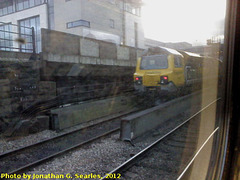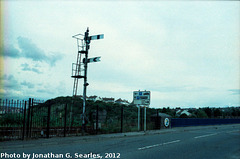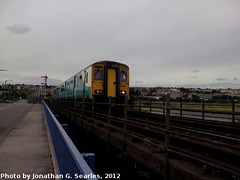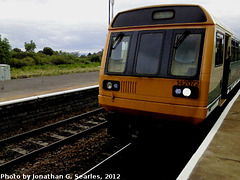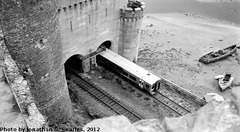
Wales
I've been visiting Wales on and off since 1999, starting with a trip to the Ffestiniog Railway, followed by many other adventures since, a number of them involving hiking trips. After posting my latest Welsh photos, of Caerphilly Castle, I decided to make a dedicated album.
Freightliner #70011, Picture 2, Cardiff, Wales (UK…
| |
|
That last shot wasn't very good, and neither is this one, but here you can see the entirety of the locomotive a bit better. The unit caught me by surprise so I wasn't able to get the cameraphone awake fast enough to get a good shot.
Semaphores on Barry Island, Edited Version, Glamor…
| |
|
These are the semaphores controlling the branch line to Barry Island. Traditional semaphores like these, often connected to mechanical interlocking systems controlled by telegraph, while increasingly rare, can still be found throughout Britain. In contrast, the branch to Barry is one of the newest in Britain, or at least one of the last to have been built in the steam era (newer light and high-speed rail projects are another story, of course), having been completed in 1896. Prior to the line's construction, there had been no road access, although as you can see there's road access now. Barry Island is primarily a seaside resort, although when I was there it seemed smaller than in fact it is. This was probably because I wasn't very interested and didn't walk around much.
Barry Scrapyard, Edited Version, Barry, Glamorgan,…
| |
|
Barry scrapyard was really my reason for visiting Barry. It's the outer end of the Barry Island branch, of course, but with a direct two-track (I don't know if it's considered mainline) connection to Cardiff. In the 1960's, when British Rail were scrapping the last of their steam, Barry Scrapyard, or Woodham Brothers, Ltd., was given most of the work. Although BR initially didn't want any of the steam preserved (for a variety of reasons, but mostly an ideological hatred of railway history), in the end the majority of it was, and Dai Woodham (1919-1994), the owner of the scrapyard, became well-known as a key figure in the history of British steam preservation. In the end, 213 steam locomotives were rescued from the yard, and 100 restored to operation. This operation took over 20 years, with many locomotives remaining in the yard into the 1980's, and as you can see here, at least two remain there today. These two appear to be BR #92245, a 9F Class 2-10-0 built at Swindon in 1959, and BR (ex-LMS) #44901, a Black 5 4-6-0 built at Crewe in 1945. Neither is likely to be scrapped, but restoration has been put off literally for decades. Woodham Brothers does little with metal recycling today anyway, having decided to rent out a large portion of their land for office units. Their website states that: "Today our main activity is providing affortable business units to Businesses in the Barry area on keyside at Woodham Barry, Barry Docks. We have 25 units up to almost 5000 sq feet, which were built in the 1970s under the leadership of the late Dai Woodham MDE, BEM."
Barry Station, Picture 2, Edited Version, Barry, G…
| |
|
Here's a shot with both the regular passenger station for Barry in the foreground, and Barry scrapyard in the background.
Barry Island, Edited Version Glamorgan, Wales (UK)…
| |
|
I wasn't originally going to post this, but I decided it was retro and weird enough so that someone might want to see it. This is close to the amusement part on Barry Island, along the road leading onto the island, although I don't know how directly connected it is to it.
Arriva #150281, Barry Island, Glamorgan, Wales (UK…
| |
|
While looking at the other extra Barry photo, I found three more, but from my cameraphone. This one is on the bridge to Barry Island on the Barry Island branch. The train is a BR Class 150 DMU, still in use after roughly 35 years (I don't know the exact build date). These were old even when I was living in Britain, and are still in service even today. They can only operate at about 75 m.p.h., but this isn't a problem on many of the branchlines in Britain, and they have an advantage over most of the newer classes because they have more luggage space, or at least usable luggage space. They're particularly handy if you're travelling with a bike.
EWS #66128, Barry, Glamorgan, Wales (UK), 2012
| |
|
EWS still operate a large proportion of the freight trains in Britain, and their primary locomotive, as planned, has become the Class 66, built by GMLG in London, Ontario during the late 1990's and early 2000's. I remember when these were being delivered, and they still look new today. GMLG, or General Motors Locomotive Group, has since been sold off by GM and is now known as EMD, an older name denoting Electro-Motive Division, which GM used from 1942 to 1990 to denote locomotives built at the old Electro-Motive plant in LaGrange, Illinois, although the new EMD is based in London, Ontario.
Arriva #142072, Barry, Glamorgan, Wales (UK), 2012
| |
|
These BR Class 142 "Pacer" railbuses were originally introduced by BR in the 1980's in an attempt at cutting costs on branchlines. Being as cut-rate as they are (like most railbuses), they have sometimes been rated by railway magazines as the most hated rail vehicles in Britain, although I'm not clear on where they got their survey data. I'm just thankful to have rail transport, although I would agree that they ride rough, they're slow (75 m.p.h.), they're loud, they're a little bit cramped, the seats are crude, and they aren't always kept clean (although this isn't a result of the design). I rode this one, now Arriva #142072, to Cardiff from Barry.
Betws y Coed, Edited Version, Conwy, Wales (UK), 2…
| |
|
Betws y Coed means "Prayer House in the Wood," but this church isn't the original one. This is St. Mary's Church, although I don't have much more information. Betws y Coed has some significance to railway history as it was one of the original stations on the Conwy Valley Line, which was a London & North Western Railway branch that connected the Ffestiniog narrow-gauge railway to Deganwy, as this connection was necessary for the Ffestiniog's slate traffic to be carried onward via coastal shipping. I don't have information on whether the Ffestiniog's backers contributed to the L&NW's building the Conwy Valley, though.
Conwy Castle, Picture 2, Edited Version, Conwy, Wa…
| |
|
This is Conwy Castle, one of the best-known historic buildings in Conwy County. It's preserved as-is, but is largely ruined, which isn't uncommon for European castles generally. The interiors were often wood, and usually these were destroyed by fire, often more than once. Once castles became obsolete militarily, the incentive for rebuilding eventually was lost. However, rot was also a factor. In the case of Conwy, I haven't been able to find out if fire was a factor, but maintenance was stopped in the 17th Century. The castle was originally completed in 1289 for James of St. George. One odd addition is a railway tunnel built through the castle mound and integrated into the castle's design, presumably for aesthetic reasons, in 1848.
Conwy Castle, Picture 8, Edited Version, Conwy, Wa…
| |
|
Here's an interior shot of one of the castle's eight turrets, which were actually built like keeps. Here you can see both where the wooden floors were, and where the hearths were.
View from Conwy Castle, Edited Version, Conwy, Wal…
| |
|
Here's a shot of the village of Conwy below the castle. Conwy is the seat for the county borough of the same name, which in turn is part of the "ceremonial county" of Clywd.
Conwy Castle, Picture 10, Edited Version, Conwy, W…
Abandoned Boats Near Conwy Castle, Edited Version,…
| |
|
Many ports and harbors throughout the world are littered with centuries of abandoned boats, and Conwy seems to be one of these. Certainly, few of these boats will ever sail again. Tracing their histories could be fascinating, as many perhaps have not been to sea within living memory. However, the descendents of their owners may still live locally.
Conwy Castle, Picture 12, Edited Version, Conwy, W…
| |
|
This shot shows the road bridge to the castle mound on the left, dating in its original form to 1826, and the rail bridge from 1848 in the middle.
Tracks Under Conwy Castle, Picture 4, Edited Versi…
| |
|
|
|
Here are the rail tunnels through the castle. These aren't unique in Britain, but are unusual, even surrealistic. This is the edited version, but I wasn't able to decide whether this one was better than the original. Consequently, I've posted both. The DMU was a Class 158 operated by Arriva, but I wasn't able to get the number.
Tracks Under Conwy Castle, Picture 4, Conwy, Wales…
Snowdon, Edited Version, Snowdonia National Park,…
| |
|
Snowdon, at 1085 metres, or 3,560 feet, is the tallest mountain in Wales. Recently, I was in a group who climbed it, making it my first summit in many years. This was my first proper film photo on the way up.
Jump to top
RSS feed- Latest items - Subscribe to the latest items added to this album
- ipernity © 2007-2024
- Help & Contact
|
Club news
|
About ipernity
|
History |
ipernity Club & Prices |
Guide of good conduct
Donate | Group guidelines | Privacy policy | Terms of use | Statutes | In memoria -
Facebook
Twitter

